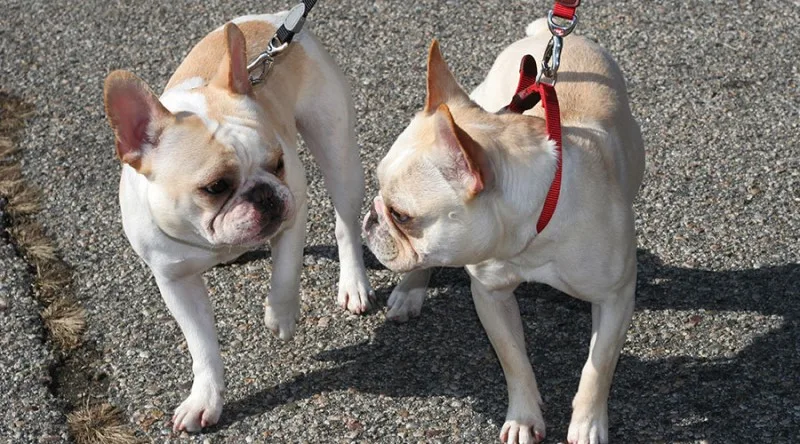Reading Dog Body Language to Socialize Your Dog
Understanding dog body language when introducing new furry friends helps with socialization. Learn tips on how to read canine postures and body language.

Training Your Dog to Interact with Other Dogs
What is your dog saying with their “canine body language” when nearing another dog? Is your dog being courteous, rude, or offering mixed messages? In this article, you will learn how to read dog body language and recognize the canine cues when introducing two dogs. By knowing what to do when trying to introduce new furry friends, you'll be setting your dog up for success.
Reading Dog Body Language When Two Dogs First Meet
It’s best to let your pup meet a new friend when both canines are offering the appropriate body language to one another. All polite dog introductions and interactions should include some of the below signals from both dogs:
Approaching the other dog in a sideways arc (instead of head-on)
Moving slowly and calmly (without rushing)
Avoiding direct eye contact (it’s a sign of bad manners in the language of dogs)
Offering soft eyes
Portraying relaxed and loose (not tense) ears, tails (soft, not frantic, wagging), and bodies
Understanding Dog Body Language in Social Settings
Dogs offer the most natural body language when they are off leash and in a neutral environment. A neutral territory is an area that neither dog thinks they own or have the right to be territorial over. Having your dog meet another dog with one or both dogs on-leash may create additional stress for the dogs, and interrupt natural canine communication patterns.
What to Be Aware of When Your Dog Meets Other Dogs for the First Time
Inappropriate greetings may involve a scenario in which both dogs are straining their necks and bodies at the end of their leashes, hard staring at one another, giving each other whale eyes (the whites of their eyes are showing), licking their lips, and greeting each other head-on with stressed facial expressions. Other warning signs of discomfort or “dog rudeness” may include an arched neck, pinned back ears, hackles up (this indicates over-arousal), a high and/or frozen tail, lunging or rushing toward the other dog, and stiff overall posture.
Introducing Two Dogs: Leash Greeting and Parallel Dog Walking
When learning to introduce two dogs, understanding dog body language will ensure that you know when to back away and/or effectively control your dog. To remove some of the stress of leash greeting two dogs, it's important for both dog owners to remain calm, as dogs have a keen sense for the general demeanor of humans. Likewise, a fearful dog is a dog that has a hard time learning anything new -- by keeping your cool, you teach your dog to do the same.
When introducing two dogs, try parallel dog walking before allowing them to meet on leash. Instead of letting the dogs meet immediately, start walking down the street in the same direction and parallel with the other dog and handler. With the dogs near each other but not close enough to touch or interact, they can relax as they get to know the smell and demeanor of their newfound friend. During the walk, gradually allow the dogs to get closer together until they are walking side-by-side. As they get closer, they will realize that the other dog is not a threat to them or to you.
Once you notice that both canines are relaxed, allow them to meet side-by-side, but this time without you or the other handler between them. You may or may not decide to let your dog greet another dog on-leash, but either way, introducing two dogs is an exercise in allowing your dog to become better socialized.
Games and Tips for Socializing Your Dog
Play the “Look at That” (LAT) game by Leslie McDevitt when you see new dogs -- this will help your dog stay relaxed. McDevitt describes this in her book, “Control Unleashed.” Instead of asking your dog to look away from something stimulating, such as another dog, you reward your dog for peacefully looking at the interesting “item.” When your dog is able to calmly look at another dog, say “Yes.” Then, your dog should reorient toward you to get their treat! In this way, your dog will learn that they are allowed to look at other dogs and will associate calmly observing with positive reinforcement. This will also help your dog remain relaxed around other dogs for longer periods of time.
A Final Word on Dog-On-Dog Interactions
Ultimately, you are your dog’s advocate. Study your dog to recognize their canine body language. Remember, it's okay to say “No” to greetings from human handlers, especially if you think your dog seems nervous or if either dog is offering up impolite body language.
Take some of the stress out of pet ownership with Accident & Illness Coverage from AKC Pet Insurance (underwritten by Independence American Insurance Company). Our pet insurance plans are designed to be there when you need them, allowing you to focus more on the health of your pet and less on costly veterinary bills. Click here for a quote today!

Jasey Day holds the Certified Canine Fitness Trainer (CCFT) credential through the University of Tennessee. She is a member of the Bobbie Lyons K9FITteam - a team of compassionate canine fitness instructors who actively teach others and continually expand their own knowledge. Since 2004, Jasey has taught a variety of workshops and classes on the following: Puppy, Canine Good Citizen/Family Pet, Advanced Family Pet, Canine Fitness, Canine Swimming, Rally, and Agility. In addition, Jasey has earned over 60 titles in Dock Diving, Agility, Rally, CGC and Trick Dog. Jasey has worked full time for the American Kennel Club since 2007 and teaches at Care First Animal Hospital in Raleigh, NC. Jasey’s Labrador Retrievers spend their free time hiking, training, and snuggling with Jasey.
READ MORE ARTICLES

